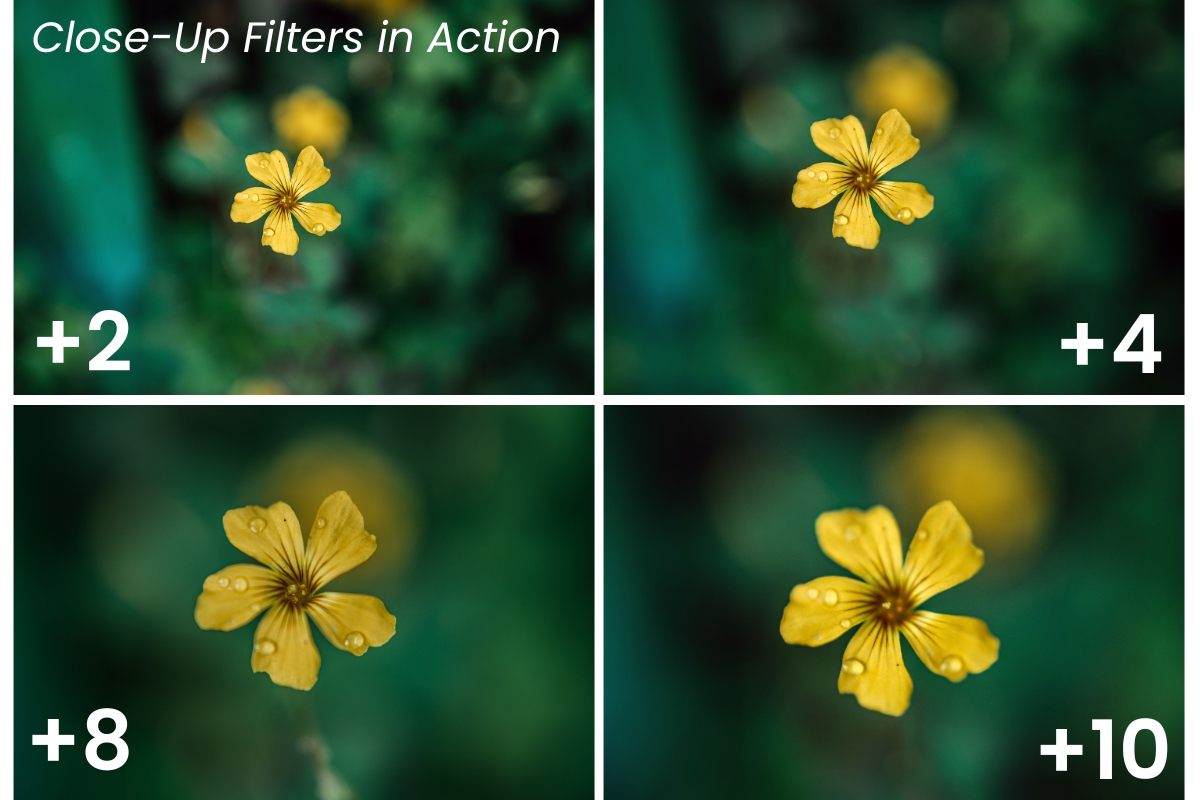Close-Up Filters: The Pocket-Sized Secret to Stunning Macro Photos
Want to get closer without getting complicated? If you’ve got a camera and a lens — especially a zoom or telephoto — a close-up filter might be the most straightforward way to enter the world of macro photography. No disassembly, no adapters, no stress.

In this guide, we’ll explore:
- What close-up filters are (and what they’re not)
- How to choose the right one for your lens
- How to use them for maximum quality and creativity
- Real-life examples and best practices
What Is a Close-Up Filter?
A close-up filter, or macro filter — sometimes called a diopter — is essentially a magnifying glass that screws onto the front of your lens, like a UV or polarizer filter. It shortens your lens’s minimum focusing distance, letting you get closer to your subject and increase magnification.
📏 Think of it like putting reading glasses on your camera lens.
🔢 Diopters Explained: +1, +2, +4… What Do They Mean?
Diopters are measured by strength — the higher the number, the stronger the magnification:
- +1: Slight magnification; ideal for portraits with a soft background
- +2: Good for moderate close-ups (flowers, jewelry)
- +4 or +10: Much stronger magnification; good for fine details
 Taken with a Nikkor 24–70 mm f/2.8G at 70 mm using the JJC 77 mm Close-Up Filter Kit (+2, +4, +8, +10).
Taken with a Nikkor 24–70 mm f/2.8G at 70 mm using the JJC 77 mm Close-Up Filter Kit (+2, +4, +8, +10).
You can stack close-up filters (e.g. +2 +4 = +6), but higher powers often can’t be stacked mechanically, image quality suffers, and focusing becomes tricky as working distance drops to only a few centimeters.
✅ Pros and ❌ Cons
✅ Pros
- Incredibly easy to use — just screw it on
- No light loss or exposure compensation needed
- Perfect for handheld shooting
- Great with telephoto lenses (e.g. 70–200mm)
💡 Tip: For best results, use multi-element achromatic close-up lenses (like the Canon 500D or Raynox DCR-250).
❌ Cons
- Adds optical elements — cheap ones can degrade image quality
- Edge softness and chromatic aberration (especially with strong filters)
- Must match your lens’s filter thread diameter (or use step-up/down rings)
- Limited depth of field with higher diopters
💡 Tip: Check your lens barrel or lens cap for the “Ø” symbol (e.g., Ø77 mm). This tells you the filter diameter you’ll need.
🔄 Quick Setup Guide
- Find the correct filter size for your lens — marked with a “Ø” (e.g., Ø67mm).
- Screw the filter onto your lens like a regular filter.
- Switch to manual focus for better control.
- Move closer to your subject — each diopter has an ideal working distance.
- Shoot with a small aperture (f/8–f/11) for more depth of field.
Best Close-Up Filters for Macro Photography (With Prices)
| Product | Diopter Power | Type | Price (USD) | Notes |
|---|---|---|---|---|
| JJC 77 mm Close-Up Filter Kit | +2, +4, +8, +10 | Basic Multi-Diopter | ~$34 | Strong value with full range of options |
| Hoya Close-Up Set | +1, +2, +4 | Basic Glass | ~$40–60 | Budget-friendly starter kit |
| Raynox DCR-250 | +8 | Clip-on, Achromatic | ~$60–90 | Clips on most lenses; strong magnifier |
| Marumi DHG 330 | +3.3 | Achromatic | ~$70–100 | Excellent all-around image quality |
| Canon 500D | +2 | Achromatic | ~$80–120 | Best for 70–200 mm lenses |
🧪 Did You Know? Achromatic filters reduce color fringing and improve sharpness, especially at the edges.
💡 Pro Tips for Success
- Use a tripod for maximum sharpness
- Clean your filter — macro magnifies dust too
- Avoid stacking more than two filters
- Use a lens hood to cut down on flare
- Experiment — shoot through frosted glass or water for dreamy effects
Final Thoughts: Macro That Fits in Your Pocket
Close-up filters are the easiest entry point into macro photography. They’re portable, affordable, and require no special knowledge or disassembly. Just screw one on, get closer, and start exploring the tiny world all around you.
Whether you’re capturing flower petals, old coins, or the texture of your dog’s nose, close-up filters open new creative doors — without breaking the bank.
👉 Coming Next: Close-Up Filters vs Extension Tubes